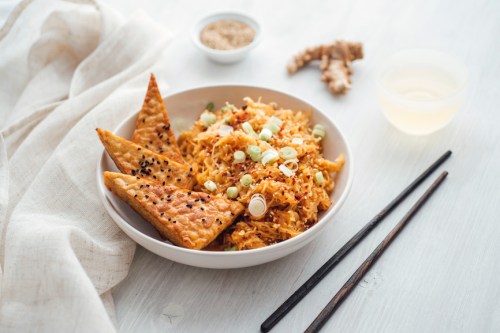The Easiest Way To Boost the Gut Health Benefits of the Probiotic Foods in Your Diet
A registered dietitian and gut health expert explains why heating probiotic foods kills their gut-boosting bacteria (and potential).

Does the mere thought of probiotic foods make your mouth pucker up in anticipatory delight? I know mine sure does. Kimchi, kraut, kombucha: You name it, I want it (as well as their gut-boosting and health-protective benefits, TYVM).
Experts in This Article
registered dietitian and nutrition educator with Fresh Communications
However, a few things can stand in the way of maximizing the probiotic powers of certain foods, drinks, and supplements—particularly when and where stability is concerned. With that in mind, it turns out that dialing up the temperature isn’t so great for good or bad bacteria to thrive.
To discover just how concerned we should be when it comes to heating probiotic foods, we reached out to Bianca Tamburello, RDN, a dietitian based in New York City.
Does heating probiotic foods kill off good bacteria?
Tamburello gets straight to the point on this question. “Yes, heating probiotic-rich foods kills off beneficial bacteria that help keep your gut healthy,” she begins (much to my dismay as a lover of Korean kimchi stew and deli fare like melty Reuben sandwiches with extra sauerkraut). “Probiotics are hard to find in foods, so heating them before consumption means you’re missing out on the opportunity to help balance gut bacteria and reap health benefits including better digestion, immune health, and less inflammation,” Tamburello says.
At this point, you may be wondering if there’s a temperature threshold before the gut-friendly bacteria begins to die off. For instance, is there a difference between topping freshly heated quinoa with sauerkraut versus boiling said sauerkraut in a hearty soup? In one word: yes.
“All strains of live probiotics (there are hundreds!) can survive at different temperatures, but most probiotics start dying off at around 115 degrees Fahrenheit and higher,” Tamburello says.
As such, this means that heat and probiotic foods aren’t *always* incompatible—and the dietitian offers a quick tip to ensure that your probiotics have a better chance to stay alive by the time you start enjoying and digesting your food. “If you’re serving a hot meal or snack, it’s best to add the cold probiotic-rich food right before mealtime,” Tamburello explains. “For example, top kraut or kimchi on your warmed grain bowl upon serving rather than incorporating this ingredient with hot proteins or veggies.” So if your main goal is to load up on gut-boosting probiotics, you may want to avoid integrating probiotic foods directly into an environment that’s too hot for good-for-you bacteria to handle—such as on the stove in a stir-fry or in a boiling soup pot.
Of course, there are certain dishes and recipes that require heating up foods that are naturally rich in probiotics. As a consolation of sorts, Tamburello says that heating them up doesn’t completely negate other benefits, so you definitely shouldn’t worry over the idea of making them nutritionally void. “Heated kimchi and kraut, for example, still offer up fiber for digestion and nutrients for overall health,” she explains. (Cue the sound of my tummy rumbling *and* a massive sigh of relief.) Moreover, you can always enjoy these dishes but aim to get your probiotics elsewhere, such as via yogurt or fermented beverages like kefir and kombucha.
Are raw probiotic foods superior to pasteurized options?
With all this talk about heat and probiotics, Tamburello takes care to note where else temperature comes into play: with raw and refrigerated versus pasteurized probiotic foods. “Raw, unpasteurized fermented foods—which you can find in the refrigerated section [at grocers]—have significantly more healthy probiotics than pasteurized, shelf-stable options,” she shares. “The pasteurization process includes heating food at high temperatures, which kills off gut-healthy bacteria.” While this process won’t negate all of a given food’s nutritional properties, such fare shouldn’t be your go-to if you’re aiming to get the bulk of your probiotics through diet alone.
“The pasteurization process includes heating food at high temperatures, which kills off gut-healthy bacteria.” —Bianca Tamburello, RD
Instead, Tamburello suggests shopping for refrigerated probiotic foods on your grocery hauls; ideally, they’ll be clearly labeled as both raw and unpasteurized. If you’re not super familiar with probiotic foods and/or want to make sure you choose the best options for your gut and greater health, she recommends kraut and kimchi (as well as pickles, which are fermented but not necessarily probiotic) by Cleveland Kitchen in particular. “If you’re a fermented food newbie, this is a great brand to get started on your gut health journey,” she says. “They offer yummy flavors like roasted garlic and beet red krauts, and even a new mild kimchi, which is a great introduction to kimchi, as the flavor is less intense.” We also love Goshen Kimchi, which is handcrafted, rich in probiotics, and free from preservatives. Eat kimchi solo or in a salad, or as a side dish to your balanced plate. Remember: The less exposure to heat, the better.
But all things considered, Tamburello reiterates you shouldn’t stress out too much when temperature is concerned. “If your favorite recipes mix heat with probiotic foods, there’s no need to worry. Just make sure you’re eating some probiotic-rich foods cold, too, for maximum gut health benefits,” she concludes.
Sign Up for Our Daily Newsletter
Get all the latest in wellness, trends, food, fitness, beauty, and more delivered right to your inbox.
Got it, you've been added to our email list.










